Tomatoes are versatile, they come in different varieties, and the good thing about a tomato plant is that you can grow them anywhere, even on your porch or backyard.
We know very well that space is the primary concern for urban gardeners. However, you can overcome space-constraints by choosing fabric bags for growing tomatoes; it’s an easy and practical way to optimize your area.
Irrespective of whether you have a balcony or a backyard garden, you can still use fabric bags. And, if you’re wondering how to get started, we have you covered!
Read on as we provide you with the best comprehensive tips to growing excellent tomatoes in fabric tomato grow bags!
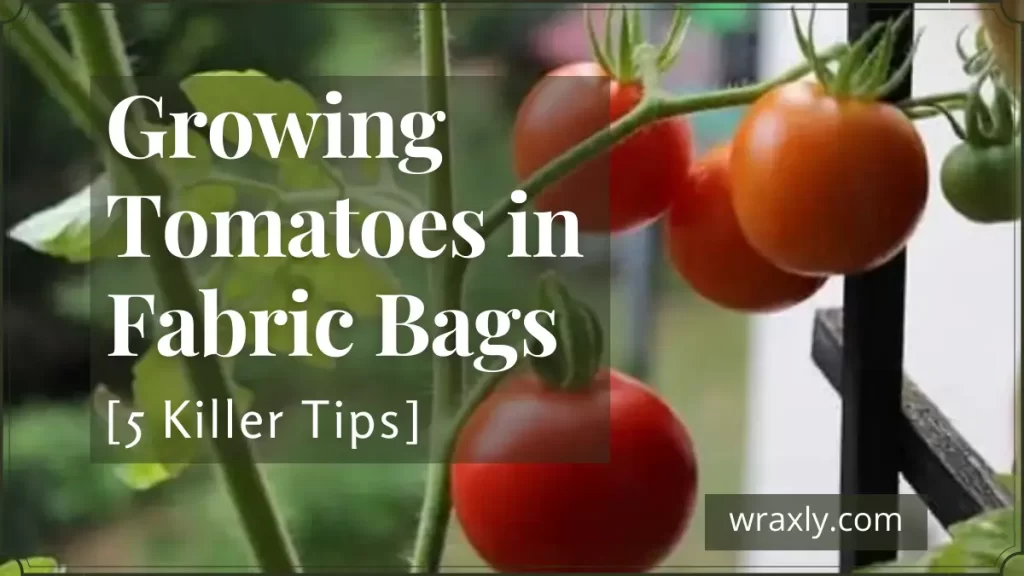
What Kind of Tomatoes Should You Grow in a Fabric Bag?
There are many kinds of tomatoes that are compact and adapted for growing in a fabric bag. Wonder what varieties are best? Here are the four fastest-growing and most suitable types of tomatoes to grow in a fabric bag:
1. Tumbler
These are also known as sweet-cherry tomatoes, and they can be harvested in a mere 50 to 60 days. Tumbler tomatoes are often referred to as the best variety to grow in grow bags.
- This vigorous, trailing British-bred tomato is ideal for hanging baskets and containers on the patio, production up to 4kg (9 lb) of delicious cherry-sized fruit in a single season.
- Grow one plant per 35cm (14) hanging basket
- (Bush variety - very easy to grow as trusses do not require support and fruits without side shoots being remove
Prices pulled from the Amazon Product Advertising API on:
Product prices and availability are accurate as of the date/time indicated and are subject to change. Any price and availability information displayed on [relevant Amazon Site(s), as applicable] at the time of purchase will apply to the purchase of this product.
2. Oregon Spring
These are some of the easiest tomatoes to grow, and their average growth time is around 65 to 70 days. This determinate variety was developed at Oregon State University.
- Tomato Seeds - Oregon Spring - 1 Oz - Solanum lycopersicum
- Non-GMO - Heirloom - Open Pollinated - High Germination Rate
- Seeds For: Vegetable Gardening
- Days to Full Maturity: 58 -- Annual -- USDA Hardiness Zone: Annual Crop, Not Intended To Overwinter
- Mountain Valley Seed Company Brand - Premium Quality Seeds
Prices pulled from the Amazon Product Advertising API on:
Product prices and availability are accurate as of the date/time indicated and are subject to change. Any price and availability information displayed on [relevant Amazon Site(s), as applicable] at the time of purchase will apply to the purchase of this product.
3. Red Robin
Red Robin is a wonderful super-dwarf determinate cherry tomato that can be grown in a hanging container or grow bag indoors or outdoors. It produces an abundance of sweet, rounded red fruits from good-looking, upright plants that reach just 12 to 18 inches tall. 55-60 days.
- US Grown Super Productive and Tasty Tomato, Easy to Grow in Container Year Round
- Keep moist, not letting the seeds dry out between watering. **SOIL Temperature for Germination: 70-75F. Planting Depth: 1/4. Sprout tomato seeds in small containers, preferably 4 or smaller. In-ground germination is not recommended. Use a standard potting mix that is well drained.
- Start seeds in containers approximately 8 weeks prior to the planned set-out date. Plants should ultimately be transplanted to the garden 1-2 weeks after the expected date of last frost. Soil should be kept consistently warm, from 70-85F. Cool soils, below about 60-65F, even just at night, will significantly delay or inhibit germination. Additionally, overly warm soils, well above 90F, can inhibit germination and provide ideal conditions for seed rot.
- Over watering can cause fungal growth which leads to seed rot. Excess water can also bury seeds deep in the soil where they will not be able break the surface. Water when the soil surface just begins to dry.
- Multiple seeds can be planted in a single starter container, but should be thinned once seedlings appear so only a single plant remains. Seeds do not require light for germination but some light source should be provided for seedlings once they emerge from the so
Prices pulled from the Amazon Product Advertising API on:
Product prices and availability are accurate as of the date/time indicated and are subject to change. Any price and availability information displayed on [relevant Amazon Site(s), as applicable] at the time of purchase will apply to the purchase of this product.
4. Sunsugar
The Sunsugar tomato is known for its sweet flavor. It’s part of a cherry-tomato family and unquestionably a delicious addition to a fresh salad.
These delightful little tomatoes are yellow-orange in color and contain great tangy flavor packed in a small cherry fruit. They produce medium size yellow cherry-tomatoes in about 62 days.
- Package = 10 Sunsugar Hybrid Tomato Seeds
- 62 days
- Germination: 8 to 14 days at 50 to 75 F
- These little tomatoes are yellow-orange in color and contain great tangy flavor
- Sunsugar Hybrid Tomatoes are thin skinned, nutritious and are crack and disease resist
Prices pulled from the Amazon Product Advertising API on:
Product prices and availability are accurate as of the date/time indicated and are subject to change. Any price and availability information displayed on [relevant Amazon Site(s), as applicable] at the time of purchase will apply to the purchase of this product.
Why You Should Use Fabric Bags To Grow Tomatoes
Here are five reasons you should use fabric tomato grow bags to grow excellent tomatoes in your house:
1. Superior Drainage
A fabric bag is made from a breathable fabric that offers improved aeration and superior drainage. It’s this increased aeration that gives fabric tomato grow bags a distinct advantage over plastic or ceramic pots.
Other growing containers have little to no aeration, and the plant’s roots, including the tomatoes, grow until they get to the container’s walls.
As this happens, the roots start signaling the plant to create more roots, resulting in the root-bound plant. Ultimately, the plant chokes itself with root masses that keep growing and filling the container.
2. Temperature Control
During intense heat in summer and the direct sunlight, ordinary pots such as plastic ones tend to get extremely hot, stunting the growth of whatever has been planted.
That’s because these pots aren’t breathable and trap heat within, causing your plant to dry up and turn crunchy brown before dying.
On the other hand, fabric bags regulate and control the temperature because of their superior breathability. You don’t have to worry about excess heat with a fabric bag as it escapes from all sides.
- Corrosion Resistant 304 Stainless Steel Case, Bezel and 12 Stem
- 32 to 178 Fahrenheit and Celsius - Perfect for smaller compost bins and piles or soil temperature measurement.
- Free PDF Digital Compost Guide Included - Expert instructions on how to get started composting and managing your compost pile for the most efficient compost production.
- Quality Glass Lens, Waterproof and Dust-pr
Prices pulled from the Amazon Product Advertising API on:
Product prices and availability are accurate as of the date/time indicated and are subject to change. Any price and availability information displayed on [relevant Amazon Site(s), as applicable] at the time of purchase will apply to the purchase of this product.
3. Easy to Store
Pots become an eyesore on your back porch when not in use. Numerous homeowners are scrambling to find ways to hide their pots from view.
They just pile up in a corner until you can use them again, taking up space and cluttering your backyard.
However, a fabric bag can be folded and stored effortlessly in a cool dry spot, consuming very little space.
4. Versatility
Apart from easy storage, fabric bags offer added convenience. They are lightweight and most sizes have handles that make them easy to move to wherever you want.
Though popular with homeowners, RV’ers also love them because they are so easy to take them in and out of their RVs, and they take up less space during storage.
5. Healthier Roots
With a fabric bag, you can prevent your plant from becoming root-bound. Growing in fabric bags promotes healthy root development through a process called “air pruning.”
In ordinary pots, roots grow in circles and they become entangled. This increases the possibility of having water stagnation or oxygenation issues, particularly in large plastic pots that lack appropriate drainage.
As roots continue to grow, they suffer structural damage, resulting in the roots becoming less able to absorb nutrients and water.
Unlike plastic pots, you won’t face any of these problems with a proper-sized fabric fabric bag. It will result in your tomato plants developing fibrous roots, which results in more water and nutrient absorption.
Now that you know why you should use fabric tomato grow bags to grow tomatoes in your house, let’s discuss how you can grow them properly.

5 Tips for Using Tomato Grow Bags
Growing tomatoes in fabric tomato bags is an ideal way to create a small garden in a limited space.
Though there are many container gardening methods and products, none is as easy to use as growing tomatoes in a fabric bag.
To help with your gardening success, here are five tips you need to follow to grow the best tomatoes in fabric bags.
1. Choose The Right Size Fabric Bag
Before you get started with growing tomatoes, the first and the most crucial thing is to select the correct size fabric bag for your tomato plants.
Tomatoes grown in containers should be at least 10 to 12 inches in diameter and depth. This will provide your plants with enough soil and nutrition for proper growth. Larger containers are also a good option, with the main benefit being that a large container will have more water-holding capacity, and thus will need less attention.
2. Use A Top-Quality Growing Medium-Mix
Make sure to fill your fabric bag with high-quality growing medium-mix if you want to grow tomatoes successfully.
- For more nutritious and tasty vegetables
- Optimum levels of primary plant nutrients
- Contains no GMOs, chicken manure or sewage sludge
- Feeds for several months
- Made with 100% organic and natural ingredients
- Contains pro-biotic, seven champion strains of beneficial soil microbes plus ecto and endo mycorrhizae
- More abundant crops; More nutritious and tasty vegetables
- 100 percent natural and organic; Exceptional results because nutrients are released quickly; Feeds for several months; Consistent premium quality
- Eight select strains of ecto and Endo Mycorrhizae contribute to drought tolerance, enhanced nutrient availability and increased plant performance
- 100-Percent organic formula provides optimum levels of essential plant nutrients; eliminates the need for chemical fertilizers when used as direc
Prices pulled from the Amazon Product Advertising API on:
Product prices and availability are accurate as of the date/time indicated and are subject to change. Any price and availability information displayed on [relevant Amazon Site(s), as applicable] at the time of purchase will apply to the purchase of this product.
Planting tomatoes in the soil makes them highly vulnerable to soil-borne diseases. In contrast, tomatoes planted in fabric bags with a quality planting mix are more resistant to diseases.
So, to fill up your fabric bag, use a 60/40 mixture of finely-screened compost and top-quality, coir or peat-based potting soil.
You don’t have to worry about the high-percentage of compost mixture being too-dense for proper root growth because fabric bags are constructed of porous fabric, ensuring the roots of your tomatoes are well aerated.
The compost used in this blend has a relatively high water holding capacity, minimizing the need to water the plants.
And the micro and macro-nutrients inside the compost mixture release slowly to feed the plant over a gradual period.
Compost blend is a well-known disease suppressor. Various studies have proven that tomatoes grown in soil mixed with compost tend to have a low chance of developing diseases, especially those resulting from soil-borne pathogens.
The potting-soil mixed in compost increases drainage and makes the fabric bag lighter. If it includes fertilizer, it will also feed your growing tomatoes.
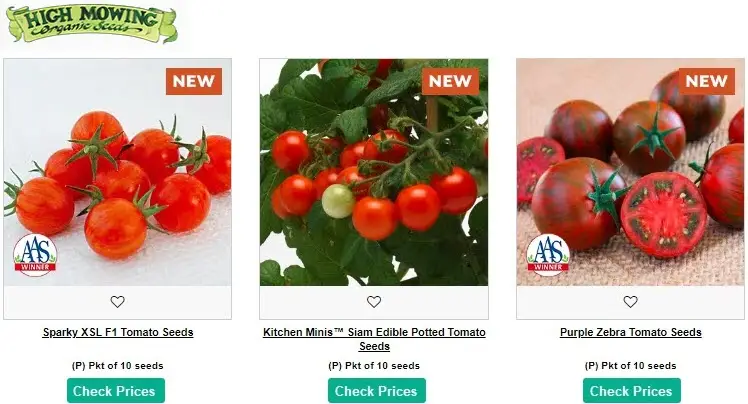
3. Watering Tomatoes Wisely
Remember watering your tomatoes is a must! Being irresponsible with your watering routine can be fatal for the growth of the plant.
Here’s a fun fact to prove the claim: numerous studies have shown that regular irrigation increases overall yields.
Conversely, if you don’t irrigate your plants daily, it will lead to blossom-end rot, a disorder that occurs in plants that lack adequate calcium. It leads to the development of a dark canker at the end of the fruit.
Tomatoes that grow in aerated fabric bags filled with an appropriate blend of growing medium-mix will need regular irrigation throughout the summer and less often during winter.
- This kit has everything you need to get started with drip irrigation and stop watering your plants by hand
- Three simple steps to install This kit. Completely customizable kit to water your potted plants, hanging baskets
- Comprehensive kit included
- The timer and supply tubing are threaded just like a hose, making it easy to hook up and start using your system
- It is so easy that if you can attach a garden hose, you can install This sys
Prices pulled from the Amazon Product Advertising API on:
Product prices and availability are accurate as of the date/time indicated and are subject to change. Any price and availability information displayed on [relevant Amazon Site(s), as applicable] at the time of purchase will apply to the purchase of this product.
Deep irrigation is perfect for tomato plants. So, when you water tomatoes, don’t just sprinkle them; instead, water them thoroughly so that each watering session soaks their roots. Water plants in the morning for the best success. Watering plants in the evening keeps roots and leaves wet longer, thus encouraging the development of diseases.
Moreover, for maximum disease control, make sure to keep foliage dry during water sessions. That’s because wet foliage gives rise to fungal diseases.
4. Provide Your Tomatoes With Essential Support
Tomatoes will require support as they grow. They can be supported either through staking or caging tend to be more productive and produce higher quality fruits than unsupported plants. Tomatoes on supported plants are also easier to harvest.
Staking
Staking is a good way to support tomatoes plants. When staking tomatoes, here are a few important factors to consider:
- Set the stakes in place at the time of planting and should be placed about 4 inches from the plant
- The tomato plant should be tied to the stake by fastening a soft cloth in a “Figure 8,” one loop around the stake and the other around the main stem of the tomato plant
- Select one main stem per plant when staking
- Natural finish,Strong and durable
- Use indoors or outdoors
- Lightweight stakes have smooth, attractive finish
- Approximate diameter 8-1
Prices pulled from the Amazon Product Advertising API on:
Product prices and availability are accurate as of the date/time indicated and are subject to change. Any price and availability information displayed on [relevant Amazon Site(s), as applicable] at the time of purchase will apply to the purchase of this product.
Caging
Another popular way to support tomato plants. Caging is when a tomato plant is supported on all sides by enclosing them in a wire cage. You can buy cages at any gardening center, or make your own with wire mesh such as concrete reinforcement wire. A few things to keep in mind:
- When making your own cages, remember that the cage should have a big enough opening to allow your hand to reach in and pick the tomatoes
- Cages should be set into the ground at the time of planting
- Caged tomatoes are more productive since suckers don’t need to be removed
- One disadvantage is that fruits will ripen later. This is due to a heavier fruit load with caged tomato plants.
- ENCOURAGE VERTICAL GROWTH -- The cage supports tomato or other plants, and encourages them to grow vertically. So the fruit and leaves dont weigh down the stems.
- STRONG AND STURDY -- Inside each stake is durable steel core. These stakes are covered with a heavy-duty plastic coating. It means long-lasting performance spanning several seasons.
- CONTINUOUS SUPPORT -- This cage allows constant healthy growth with the placement and movement of the snap-on arms as they easily attach to the stakes.
- EASY TO ASSEMBLE -- No tools needed, this cage takes minimal time and effort to set up. 51 inch height meets the maximum height of most tomato plant varieties. Convenient to store after dismantling.
- FOR CLIMBING PLANTS -- This garden cage is designed specifically for vertical climbing plants to provide support. Perfect for growing tomato plants, pole beans, cucumbers, grapes, and ki
Prices pulled from the Amazon Product Advertising API on:
Product prices and availability are accurate as of the date/time indicated and are subject to change. Any price and availability information displayed on [relevant Amazon Site(s), as applicable] at the time of purchase will apply to the purchase of this product.
5. Use Mulch
Mulching is a key for gardening; in fact, it’s a crucial practice for sustainable gardening. The importance of mulch is even higher when it comes to fabric bags or other container gardening because it helps retain soil moisture.
You can employ any mulch you like, but we recommend straw, chopped leaves, grass clippings, wood chips, compost, shredded bark, or pine needles and cover soil by a minimum of 2-inches. Make sure you don’t cluster it against stems.
One mulch layer can last the entire summer!
- Unlike fabrics and covers, straw is actually good for your garden. Contains no chemicals.
- It blocks out the sun, preventing hidden weeds from growing and preventing them from germinating
- It retains moisture, so your soil stays damp longer (meaning you won’t need to water as often)
- It shades your soil so cool season crops don’t bolt as soon, and encourages worm habitat.
- As the straw breaks down and composts it acts as a fertilizer and improves your so
Prices pulled from the Amazon Product Advertising API on:
Product prices and availability are accurate as of the date/time indicated and are subject to change. Any price and availability information displayed on [relevant Amazon Site(s), as applicable] at the time of purchase will apply to the purchase of this product.
For Further Reading
- Plum Tomatoes Demystified
- Don’t Plant Cucumbers and Tomatoes Together: Here’s Why
- Unlock the Secret to Growing More Delicious Tomatoes
- How to Master Hydroponic Tomatoes
Final Thoughts on Using Tomato Grow Bags
Hopefully, now you know how easy it is to grow flavorful tomatoes, even without a backyard.
You can get your fabric bags from various garden centers and nurseries, or you can buy them online.
Your best bet would be to buy fabric bags from Wraxly. And if you are new to home growing, you will be happy to know that these bags come with a quick-start planting guide.
Don’t just take our word for it; check out the number of positive reviews on Amazon.

Darrell has a passion for gardening that he inherited from his father. Go here to read more about the influence his father played in his love for gardening. If you want to send Darrell a quick message, then visit his contact page here.










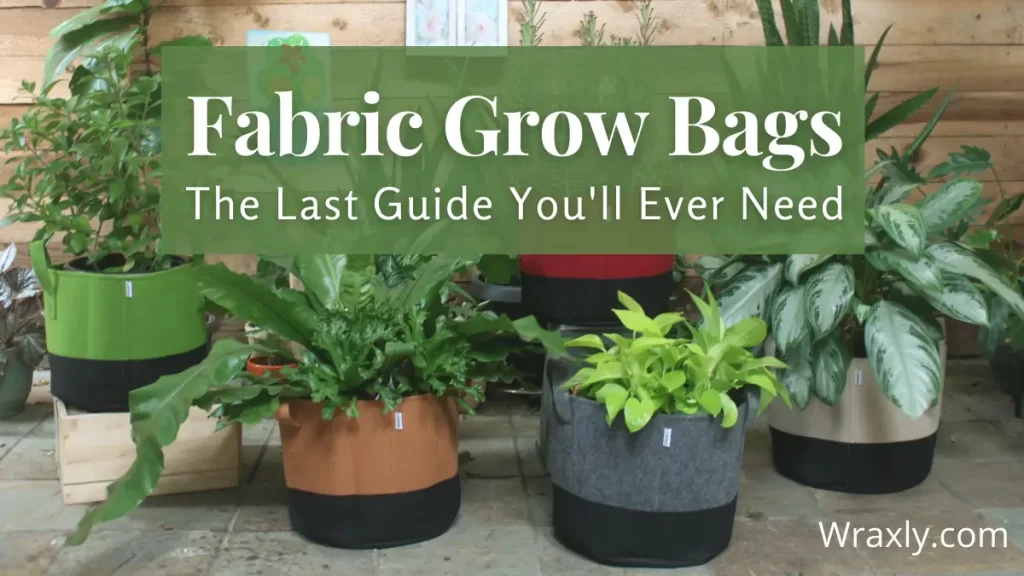
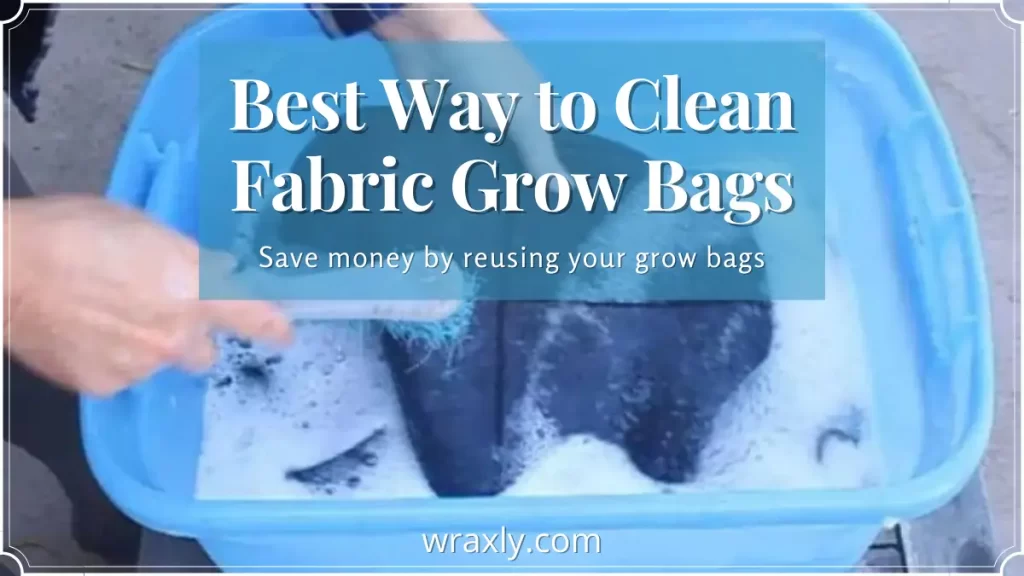
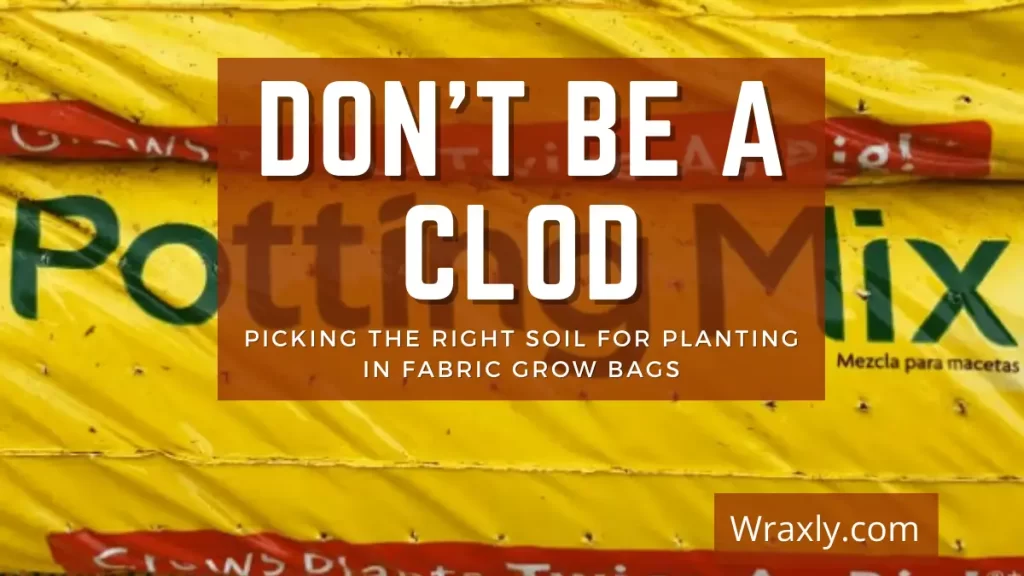
![Container gardening for beginners [Buying guide]](https://wraxly.com/wp-content/uploads/2021/02/Container-gardening-for-beginners-Buying-guide-1200-1024x576.webp)
